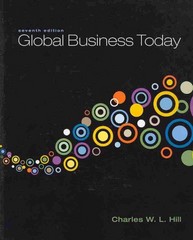In the 1990s Argentina was the darling of the international financial community. The country had fixed the
Question:
In the 1990s Argentina was the darling of the international financial community. The country had fixed the exchange rate for the Argentinean peso to the U.S. dollar at $151 peso. Maintaining the exchange rate had required Argentina to adopt strict anti-inflationary policies, which had succeeded in bringing down Argentina’s historically high inflation rate and stimulated economic growth. By 2001, however, the economy was running into trouble. Global economic growth slowed and demand for many of the commodities that Argentina exported had fallen in tandem. Argentina’s large neighbor and main trading partner, Brazil, was grappling with a financial crisis of its own and had devalued its currency against the dollar, and thus the peso, effectively pricing many Argentinean goods out of its market. To compound matters, the dollar had appreciated against most major currencies, taking the peso up with it, and making Argentinean goods more expensive in other international markets.
Starting in 1999, the Argentinean economy entered into a tailspin that was to take unemployment up to 25 percent by 2002. Anticipating that the country would have to devalue the peso against the dollar, corporations and individuals started to pull money out of pesos, placing their funds in dollar accounts. As people sold pesos, the Argentinean government used its foreign exchange reserves to buy them back in an effort to maintain the exchange rate at $15 1 peso. The government quickly ran down its reserves, and in 2000, the country negotiated a loan from the International Monetary Fund (IMF) to prop up its currency. In return for the loan, which ultimately reached $15 billion, the Argentinean government agreed to adopt a financial austerity program to balance its budget. However, conditions in the country continued to deteriorate, in no small part some critics claimed because the strict IMF policies made an already bad recession worse. By late 2001, with government tax revenues plunging as the economy contracted, the Argentinean government defaulted in its debt repayments, effectively rendering $80 billion of government-issued bonds worthless. This created a massive crisis of confidence, which put further pressure on the peso. Throughout 2001 the Argentina government had been trying to support the value of the peso with the help of the loan from the International Monetary Fund, but it was becoming ever more difficult, and the debt default was the final nail in the coffin. In early 2002, the government bowed to the inevitable and decoupled the peso from the dollar, allowing it to float freely. It immediately fell to $1 5 3.5 pesos.
The fall in the value of the peso helped to revive Argentinean commodity exports, which were now much cheaper for foreign buyers. A rebound in global economic growth after 2001 also helped, as did an economic recovery in neighboring Brazil. By 2003, the economy was once more on a growth path and unemployment was falling. In 2005 Argentina repaid its entire debt to the IMF. Commenting on the debt repayment, Argentinean President Nestor Kirchner criticized the IMF for promoting policies that “provoked poverty and pain on the Argentine people.” While that view was popular in Argentina, some outside observers worried that freed from IMF constraints, the Argentinean economy would return to its historic norm of lose monetary policy and high inflation.
Questions
1. Why do you think Argentina adopted a fixed exchange rate policy in the 1990s?
2. To what extent did the fixed exchange rate policy contribute to Argentina’s economic problems in 2000–2001? Would Argentina have been better off during this period with a floating exchange rate?
3. The IMF policy for Argentina included deep cuts in government spending and a sharp rise in interest rates? Why do you think the IMF thought these policies were necessary? What was the cost of these policies to Argentina? Was there another way of dealing with the crisis?
4. In late 2008 commodity prices again fell sharply. What do you think was the impact on Argentina? What would you expect to happen to the value of the Argentinean peso against major currencies? What actually happened?
Step by Step Answer:






